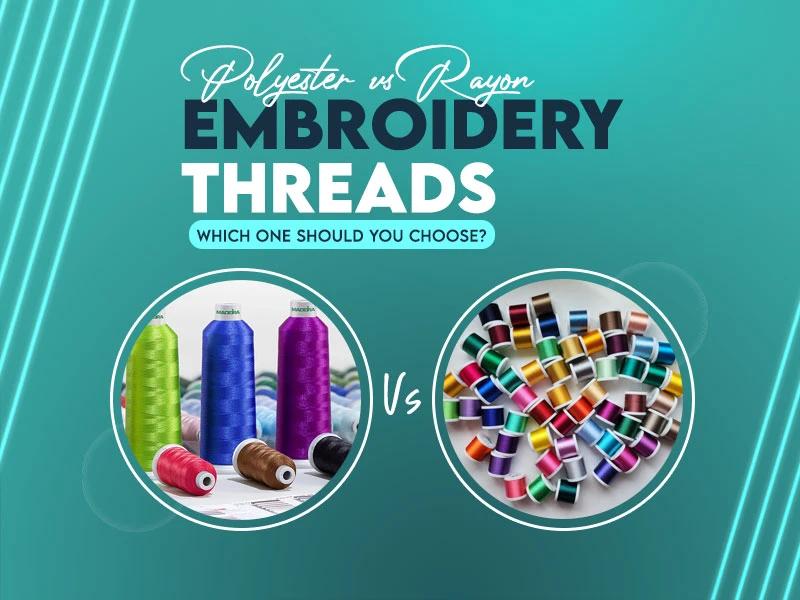
Thread is the most important essential in sewing. Sewing process does not start without threads and choosing the right thread for your design will save you from ruining designs. You can pick fabric and the right essential supplies. When it comes to machine embroidery, two threads are most common, polyester and rayon. Both look attractive but they work in different ways.
In this blog, we’ll talk about when to use each type, their good and bad sides, what they have in common and which one gives your work a more polished look.

Use polyester thread when the item will be used or washed. It’s perfect for things that need to last long like uniforms, sportswear, backpacks, towels or any fabric that gets cleaned a lot or stays outdoors. Polyester thread can control sunlight, water and even bleach so it’s great for heavy-duty use.
In short, use polyester when durability and resilience matter.

Here are some solid benefits of polyester thread. Let’s check it out.
- High durability: Polyester thread is stronger and doesn’t break easily like other threads.
- Color-fastness: It holds its color even after many washes and often resists fading.
- Resistance to chemicals and bleach: It can handle harsher conditions, which is why it’s popular for commercial or work-wear applications.
- Good for high-speed embroidery: Machines running fast prefer threads that don’t break easily; polyester often wins here.
- Wider application range: Because of its strength and stability, you can use it on heavier fabrics like denim, canvas, etc.
- Economical choice: Well cost depends on brand and quality. Polyester tends to cost less for large projects and requires replacement threads less often.
- Less machine downtime: Fewer thread breaks mean less interruption and wasted time on thread changes.
- Improved finishes over time: Polyester threads are much better in sheen and appearance than older ones and are much closer to rayon in look.
Polyester has many strong points but it also has some drawbacks you should know. Here are a few of them:
- Less natural sheen (in some cases): Though new polyesters have improved, older ones didn’t match the gloss and softness of rayon.
- Stiffer feel: Because polyester is strong and synthetic, densely stitched areas can feel stiff or less smooth.
- Potential for puckering: If the fabric is lightweight and the thread is strong/stiff, the embroidery might pull or pucker.
- May show more tension issues: Because it stretches differently or behaves differently, machines need to be well tuned.
- Not always the luxury look: For high-end fashion or decorative pieces where sheen and softness matter most, polyester may not deliver the same “luxury” feel.
- Heat sensitivity: Some low-quality polyesters or poorly running threads might react badly to high heat or pressure. (But better than rayon in many cases, quality matters.)
- Not good for soft or thin fabrics: If you’re stitching a very lightweight, fine fabric, the strong nature of polyester might dominate or damage the fabric a bit.
- Brand/quality variation: Polyester is so widely used, there is a big range in quality and price. Choosing a cheap and low-quality polyester will give bad results.
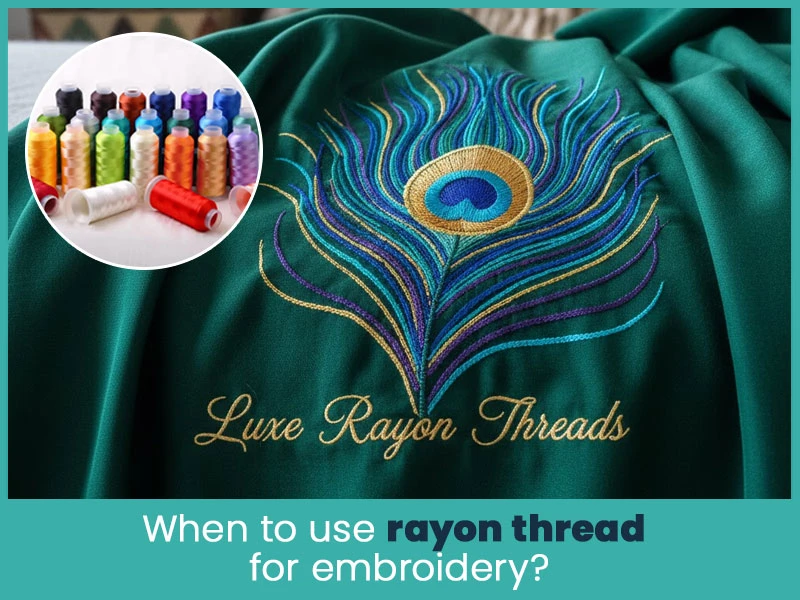
Rayon thread is best when the look matters a lot and when the embroidered item isn’t going to face heavy wear or harsh conditions.
Take some examples: Decorative apparel, home decor, logos on jackets for events, lighter use garments where you want high sheen and softness.
Use rayon when you want that “luxurious,” shiny, smooth finish and when durability under extreme conditions is less of a concern.
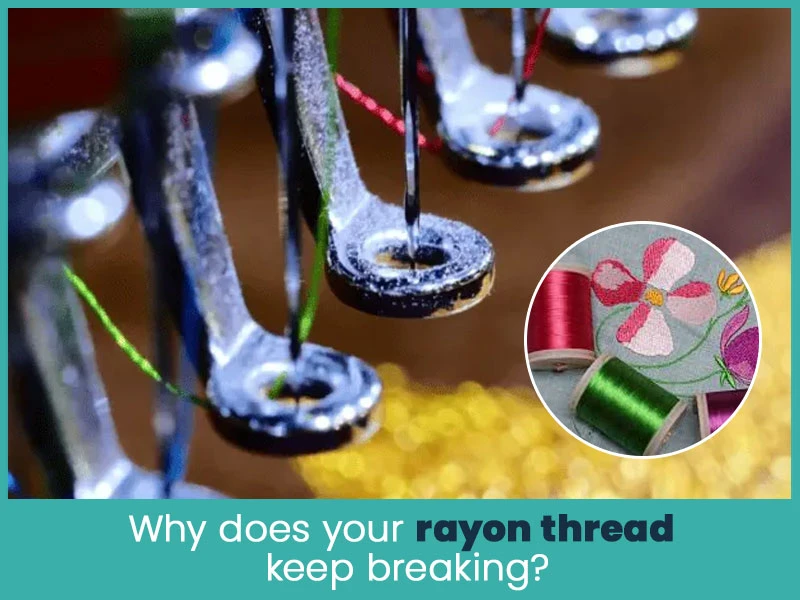
If you’re using rayon and find that your thread keeps breaking, here are some common reasons:
- The tension on your machine may be too high for the thread type (rayon can be more delicate).
- The stitch speed or density might be too high for the thread or the fabric you’re using.
- The thread might be low quality or not suited for machine speed.
- You may be embroidering on a fabric or under conditions (lots of washes, rough fabric surface) that stress the thread more than it’s built for.
- Improper needle size or machine setting mismatched to the rayon thread weight and type.
Because rayon is softer and less resistant to extreme use, it requires more care and correct settings for smooth results.

- High sheen and beautiful finish: Rayon has a shiny, smooth surface that makes designs stand out.
- Soft texture: On any fabric, especially lighter fabrics, rayon feels softer and more comfortable.
- Excellent color vibrancy: Rayon takes dye well and can give rich, vibrant colors.
- Good for decorative work: Because of that finish, rayon is ideal for logos,applique, home decor, gifts, etc.
- Better on finer fabrics: For lightweight fabrics or frequent wearing, where you want a subtle look rather than rugged.
- Usually gives a softer finish: Compared to some poly threads, rayon conforms more softly to fabric, less likely to “unique” in a negative way.
- Aesthetic look: If the garment is fashion-oriented rather than utility-based, rayon gives a luxury look at a lower cost than silk.
And now seven drawbacks of rayon:
- Rayon generally cannot match polyester in extreme wear, heavy laundering or exposure to chemicals.
- It can break easily on the machine if it’s not set up right because the thread is very delicate.
- It may fade faster than polyester under strong sunlight or repeated washing.
- Not ideal for outdoor or heavy-use items. If the item will be washed often or used heavily, rayon might not hold up well.
- Requires more care in storage/handling. Because moisture, tension or machine speed may affect its behavior more.
- Possibly less cost-effective for heavy usage. Given the risk of wear and breakage, more frequent thread changes may offset the initial benefit.
Limited to very heavy fabrics/settings. If you’re stitching on canvas, thick denim, or items that get rough use, rayon thread may not be the right choice.

- Even though they differ, polyester and rayon have several qualities:
- Both are widely used in machine embroidery and are available in many colors and weights.
- Both create beautiful embroidered designs when used correctly.
- They both require matching with the right needle and machine settings for best performance.
- They are easier to find and more affordable than many specialty threads like silk or metallic for typical use cases.
- They both play nicely with most fabrics when properly matched, although one may perform better in a given situation.
If your goal is luxury, aesthetic finish, high sheen, comfort on lighter fabrics, then rayon is the winner. The glossy surface and smoother feel make it great for decorative wear, upscale garments or logo work where appearance matters more than rugged durability.
However, that doesn’t mean polyester can’t look good. New polyester threads have improved finish and sheen and if durability and longevity are equally important, polyester may actually give you a “luxury look that lasts,” which in itself feels more premium.
To pick the right thread for your project, follow these simple steps:
- Check the use case: Will the item be washed often? Will it see outdoor use or rough wear? If yes, polyester is likely better. If it’s for decorative use or lighter wear, rayon could be better.
- Match the fabric: Heavy fabrics ask for strong threads; delicate fabrics for softer threads.
- Consider appearance: Do you want a glossy, luxury look? Go for Rayon.
Do you want reliability and durability? Polyester is best.
- Look at machine settings: Make sure your machine needle, tension and speed match the thread you pick.
- Budget: For large runs or industrial use, sometimes cost + durability favour polyester. For smaller decorative projects, you may invest in good rayon.
- Test a sample: If possible, do a small test run to see how the thread behaves on your fabric and machine.
- Consider the brand/quality: Choose well-reviewed thread from reliable manufacturers rather than the cheapest option.
There isn’t a one size fits all “best” thread. The best quality thread is the one that matches your project needs and performs reliably with your machine and fabric. A top-quality polyester from a trusted brand on large use items is “best” for those conditions. A high-quality rayon that runs smoothly, gives a beautiful finish and suits decorative use is “best” for other conditions.
In short, quality + suitability = best results.
Choosing between polyester and rayon embroidery threads comes down to understanding what your project demands. If you need durability, frequent laundering, outdoor exposure or heavy use, go with polyester. If you prioritise shine, luxury appearance, decorative use and lighter wear, rayon may be your best choice.
At True Digitizing, we understand how thread choice affects the final outcome of your embroidery work. Whether you’re digitizing logos, creating custom apparel or working on home decor pieces, you’ll want to match your thread to your fabric, use case, machine and appearance goal. Choose wisely, test when possible, and you’ll get results that look great and last.
Ready to take your embroidery to the next level? Explore our services today and let us create your favorite design. We digitize your designs carefully and give complete attention to the details of every design. So contact us today and place an order now.
Nick William has been immersed in the world of embroidery digitizing for over 20 years, earning 25 industry awards throughout his career. As a 3rd generation embroidery expert, Nick’s journey started in his family’s workshop, where he learned the art of digitizing before the rise of modern software. He has worked with leading commercial embroidery businesses and has shared his expertise with over 75,000 home and professional embroiderers. As an author at True Digitizing, Nick is passionate about teaching others how to create beautiful, precise designs through easy-to-follow tutorials and expert advice.
Categories
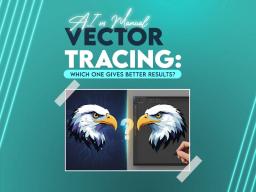
AI vs Manual Vector Tracing: Which One Gives Better Results?
06-11-2025

Metallic Embroidery Thread | Tips, Tricks and Common Mistakes to Avoid
04-11-2025

Hatch vs Chroma: Which Embroidery Software Should You Choose?
30-10-2025
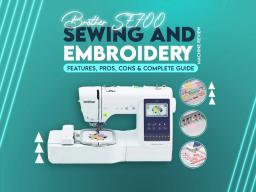
Brother SE700 Sewing and Embroidery Machine Review | Features, Pros, Cons & Complete Guide
28-10-2025

Trending Halloween Fonts for Embroidery Patches & Designs
23-10-2025

From Cap to Full Back: Expert Tips for Resizing Embroidery Designs
22-10-2025

How to Resize Embroidery Designs to Fit Your Hoop Without Errors?
17-10-2025

Fixing Embroidery File Color Errors | A Step-by-Step Guide
15-10-2025

Digitizing Superhero Logos for Kids’ Jackets and Hoodies
09-10-2025

Trendy Embroidery Keychains for Teens & Gen Z Fashion Lovers
02-10-2025